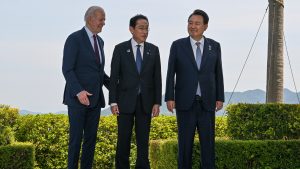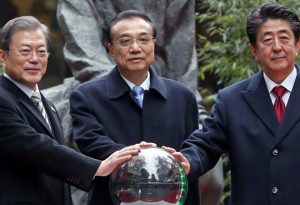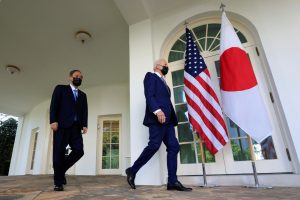
I posted recently here at Alan’s Newsletter on the upcoming BRICS Summit – Puzzling over a BRICS Enlargement. And BRICS, as I described in the Post, is a ‘big deal’ in the pantheon of Leaders’ Summits. I also noted the possible ‘reignition’ of the Trilateral Summit – China, Japan and the Republic of Korea (Korea). But this is not the current extent of summit activity. There is, in fact, another Trilateral Summit that is about to gather – what I am referring to as a ‘Second Trilateral Summit’. This is the gathering at Camp David of the leaders of Japan, Korea and the United States. And since that gathering is tomorrow, Friday, I thought I’d get this Post out in anticipation of the Camp David Trilateral Summit of the three leaders.
‘Global summitry’ – the extent, importance and consequence of these leaders’ gatherings and the global governance progress achieved at these gatherings is, not surprisingly, at the heart of the Global Summitry Project (GSP). It is here in the e-journal Global Summitry, in our work with colleagues in the China-West Dialogue (CWD), and the strengthening of the Sustainable Development Goals (SDGs), and our work with students and researchers through the GSP including the articles, podcasts and videos.
Well let’s turn back, for just a moment to the upcoming Summit. What, you say, a second trilateral summit? Well, yes, actually. The JapanTimes sets out possible goals for such a Trilateral Leaders’ gathering – the Second Trilateral Summit :
In a major step toward making trilateral cooperation a more permanent fixture, U.S.President Joe Biden, Japanese Prime Minister Fumio Kishida and South Korean leader Yoon Suk-yeol will agree to hold three-way summits at least once a year, while also conducting more frequent joint military drills around the Korean Peninsula and bolstering intelligence-sharing, including real-time warning data on North Korean missile launches.
The three leaders are also expected to signal deeper cooperation in areas such as cybersecurity, supply chain resilience and fighting economic coercion.
The one-day meeting — the three leaders’ first stand alone summit not held on the sidelines of a separate event — will take place against the backdrop of North Korea’s ever-improving nuclear and missile programs as well as China’s growing military assertiveness. Both issues will be high on the agenda.
But first and foremost, the summit is expected to focus on laying the foundation for a more durable trilateral relationship that can withstand political change, namely the growing partnership between two of the most powerful democracies in Asia.

 While I have suggested earlier that I don’t think an initial focus on building regional or multilateral institutions is necessarily the best first step in global governance and possibly a means to ‘tone down’ geopolitical competition rhetoric and action, I am now about to contradict myself and this position. For, in the end, there are some obvious regional and international institutions that could encourage collaborative action and push global governance collaboration. And, in fact, I have in mind an obvious one that has – as a current Chinese slang term might well describe it – ‘tang ping’ 躺平 – or ‘lying flat’. It is the Trilateral Summit.
While I have suggested earlier that I don’t think an initial focus on building regional or multilateral institutions is necessarily the best first step in global governance and possibly a means to ‘tone down’ geopolitical competition rhetoric and action, I am now about to contradict myself and this position. For, in the end, there are some obvious regional and international institutions that could encourage collaborative action and push global governance collaboration. And, in fact, I have in mind an obvious one that has – as a current Chinese slang term might well describe it – ‘tang ping’ 躺平 – or ‘lying flat’. It is the Trilateral Summit.
